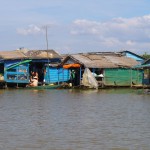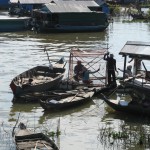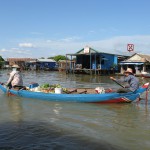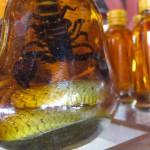The city of Angkor was made possible because of its proximity to the waters of Tonle Sap. This lake is the largest in southeast Asia, in rainy season being as long as 100 miles and as wide as 20 miles. Its shape changes with every season.

The lake is actually fed from the Mekong, which flows to Phnom Penh and branches into four rivers. One of these flows north and creates the lake out of the lowland areas.
A thousand years ago, massive engineering of canals and barays from the lake created the opportunity to provide the agriculture needed to sustain a population that eventually grew to 1 million people at Angkor Thom, the height of the Khmer empire.

Today, the lake is still the lifeblood for the many Cambodian and Vietnamese people who call Siem Reap and the lake their home. Fishing is the primary source of income and food. Around the lake people live in houseboat communities that float as the lake level changes. When the lake level drops during the dry season, the communities float, from outlying channels, deep into the lake, using the drying lake bottom to plant one crop of rice. After the harvest comes the rainy season, the houseboats return to the channels and the cycle continues.

Daily activity is brisk, with smaller boats replete with produce bought in Siem Reap in exchange for the fish. Crocodile farms bring revenue from their meat and skins. Snakes and scorpions are used to make oils and additives for homemade liquor. And, of course, there are the tourists who come to see the fascinating way of life by boat.

Everything revolves around the Mekong. It sustains and it destroys and the people here learn to adapt or die. There are many theories surrounding the total demise of the Angkor civilization. No one really knows for sure. The struggle for supremacy in the region certainly had an impact, but prolonged drought seems to have been a major contributor. Now, as then, life in this area depends on the vagaries of the Mekong.
(For more pictures from Cambodia, CLICK HERE to see the slideshow at the end of the Cambodia itinerary page.)
(To read earlier posts about our Mekong travel, CLICK HERE for Part 1 or CLICK HERE for Part 2)

